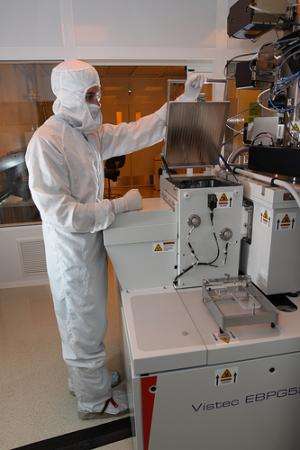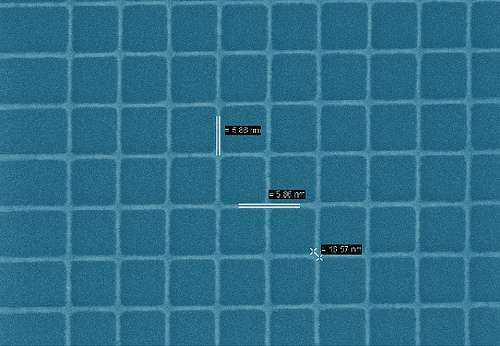New electron beam writer enables next-gen biomedical and information technologies

(Phys.org) —The new electron beam writer housed in the Nano3 cleanroom facility at the Qualcomm Institute is important for electrical engineering professor Shadi Dayeh's two major areas of research. He is developing next-generation, nanoscale transistors for integrated electronics; and he is developing neural probes that have the capacity to extract electrical signals from individual brain cells and transmit the information to a prosthetic device or computer. Achieving this level of signal extraction or manipulation requires tiny sensors spaced very closely together for the highest resolution and signal acquisition. Enter the new electron beam writer.
Electron beam (e-beam) lithography enables researchers to write very small patterns on large substrates with a high level of precision. It is a widely used tool in information technology and life science. Applications range from writing patterns on silicon and compound semiconductor chips for electronic device and materials research to genome sequencing platforms. But the ability to write patterns on the scale afforded by the Nano3 facility—with its minimum feature size of less than 8 nanometers on wafers with diameters that can be as large as 8 inches—is unique in Southern California. Before the facility opened earlier this year, the closest comparable e-beam writer was in Los Angeles. In an e-beam writer, unique patterns are "written" on a silicon wafer coated with a polymer resist layer that is sensitive to electron irradiation. The machine directs a narrowly focused electron beam onto the surface marking the pattern, making parts of the resist coating insoluble and others soluble. The soluble area is later washed away, revealing the pattern which can have sub-10 nanometer feature dimensions.
Bioengineering professor Todd Coleman will use the new e-beam writer as one essential step in the building of his epidermal, or tattoo, electronic devices. The devices are designed to acquire brain signals for a variety of medical applications, from monitoring infants for seizures in neonatal intensive care to studying the cognitive impairment associated with Alzheimer's disease or dementia, and soldiers struggling with post-traumatic stress syndrome.

Electrical engineering Ph.D. candidate Andrew Grieco is using the machine to develop a new type of optical waveguide that promises to improve efficiency and reduce power consumption. Grieco works in the laboratory of Shaya Fainman, professor and chair, Department of Electrical and Computer Engineering. Developing on-chip optical networking devices such as waveguides, switches and amplifiers is a critical step in the development of optical chips. Although information systems rely primarily on fiber-optic networks to connect and share data around the world, the underlying computer technology is still based on ele ctronic chips, causing data traffic jams.
"Any local company that has an investment in nanoscale science and technology should greatly benefit from this machine. It's a powerful tool that is hard to find in a typical university setting or within local industry," said Dayeh (Ph.D., 2008 UC San Diego), who joined the faculty in 2012. "It's a unique tool that is being brought to San Diego. "
Dayeh said technologies enabled by the e-beam writer will be important in local efforts to conduct research under President Obama's BRAIN Initiative, which will require developing much smaller sensing and stimulating elements with higher resolution on chips the size of a few millimeters. "Current state-of-the-art electro-neural interfacing technology enables sensing from hundreds or thousands of neurons. If you want to understand the neurophysiology on the individual cell basis then we need to develop sensors that have the spacing of a few tens of nanometers, which is about one-hundredth the size of a neuron and is on the same scale as their synaptic connections," he said.
Electron beam facility is open for business
UC San Diego's new Vistec Lithography EBPG5200 electron beam writer is available for use by campus researchers, as well as industry and research partners. The e-beam writer, used for nano and micro-fabrication is a new addition to the Qualcomm Institute's Nano3 facility, which provides a synergistic environment for fundamental research and development efforts at the nanoscale with a focus on nanoscience, nanoengineering and nanomedicine. In addition to providing essential nanofabrication capabilities for research on electronic and photonic materials and devices, Nano3 facilitates the pursuit of research in emerging, interdisciplinary and rapidly growing fields such as biomedical and biochemical devices, monolithic and heterogeneous integrated electronic and photonic devices and circuits, and sensor technology.
The new e-beam writer enables researchers to write fine features on a scale of less than 8 nanometers, over a large surface area up to 8 inches. The challenge of writing over large fields with electron beams is that the beam of electrons can become larger and diffused, distorting the features of the pattern. However, the EBPG5200 has superior electromagnetic focusing capability for extremely narrow electron beams over 1x1 mm2 write fields and a high stitching accuracy, which allows ultrascaled features to be written not only on research scale samples but also on commercial and production size wafers.
Provided by University of California - San Diego



















